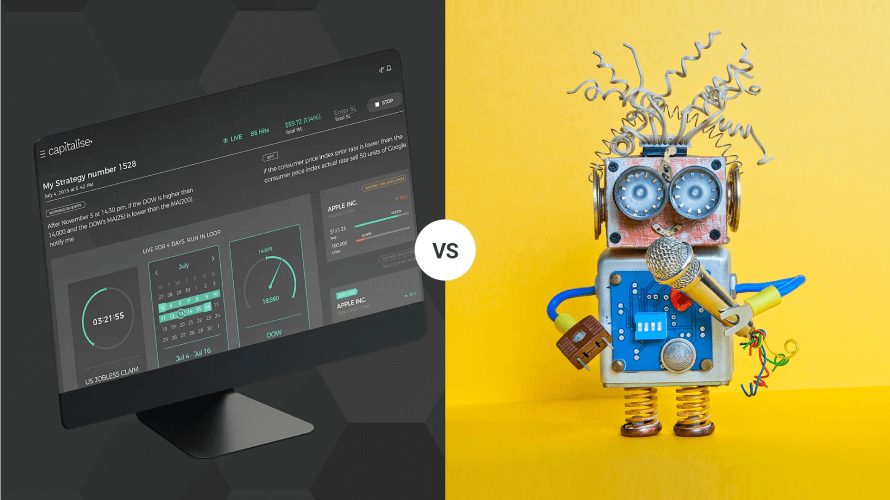Two distinct types of traders approach the markets differently either as technical or fundamental traders. Fundamental traders and technical traders are able to use different technology and data analysis within the context of trading platforms that are automated. To make informed decisions about trading Fundamental traders' focus is on financial and economic information. This includes the economic indicators, interest rates as well as corporate earnings. Fundamental traders believe that market movements are influenced by fundamental forces and it is important to understand the drivers to make informed trading decisions. Technical traders, on the other hand, concentrate on chart patterns and technical indicators to assist them in making trade-making decisions. Technical traders believe that past market trends and the behavior of markets can provide insights into future market developments and believe that technical analysis is more effective than analysis based on fundamentals. When it comes to trading software that is automated, fundamental traders are more likely to utilize algorithms that incorporate the fundamentals of data and analysis in their decision-making processes. Technical traders may employ algorithms that use technical indicators and chart patterns to assist in their decision-making. It is evident that fundamental and technical traders have different approaches to the markets. These distinctions can lead to different types of automated trading platforms they utilize. Technical traders are more likely than traders who are fundamental to employ systems which include fundamental data and analysis. However, technical traders can also use systems that incorporate technical analysis. Follow the best forex backtesting for site info including best trading bot, algorithmic trading crypto, what is backtesting, crypto daily trading strategy, best crypto indicators, automated trading system, automated trading software, best automated crypto trading bot, backtesting trading, backtesting software free and more.

Automated Trading Systems, Simple Moving Average And Exponential
Exponential Moving Averages or SMAs (also called Simple Moving Averages) and Simple Moving Averages(SMA) are common technical indicators used in automated trading platforms. They are calculated by adding the closing prices for a particular currency pair over a certain amount of time, and then dividing the result by the amount. An example of a 50-day SMA is calculated by adding the closing prices of a currency pairing for the past 50 calendar days, after subtracting 50.
The Exponential Moving Average (EMA) is like the SMA however it gives more weight to recent prices in its calculation. The EMA is calculated using a weighted average of closing prices. The weight for the current prices is more than that for older prices. This is because the EMA reacts faster to changes in market conditions than the SMA.
Automated trading systems usually employ moving averages in order to discern patterns, and to generate buy or sell signals. One common strategy is to purchase when the price crosses over the moving average and then sell when the price crosses beneath the moving average. Additionally, you can utilize moving averages to establish trends. An increasing average is indicative of an uptrend while a falling average indicates a decline.
EMA or SMA are two of the most popular technical indicators that are used for automated trading systems. These indicators can be used to determine and confirm trends, produce buy/sell signals and generate buy/sell signals. The choice between EMA and SMA is contingent on the particular needs and objectives of the investor, with the EMA being more adaptable to changes in market conditions and the SMA being a more reliable indicator of long-term trends. Follow the most popular auto crypto trading bot for blog examples including best cryptocurrency trading bot, automated trading, trade indicators, how does trading bots work, cryptocurrency trading, automated trading, stop loss and take profit, crypto futures, best trading platform, trade indicators and more.

What Is Bollinger Bands?? Automated Trading Systems?
Bollinger bands are a form of technical indicator that is commonly employed in automated trading platforms. They are composed of three lines: a simple moving median (SMA), and two outer bands. Each band is plotted along with a specific number of standard deviations to the SMA. The standard deviations used in calculating the outer bands are determined by the volatility of the underlying asset. Bollinger Bands are used to monitor fluctuations in market conditions within automated trading systems. For example, when prices move outside the bands that surround it, it may indicate the possibility of a trend reversal, or a rise in volatility. However, the reverse could be the case. If the price remains within the outer bands, it could indicate that there is a tendency for it to consolidate and a less likely trend shift. Traders may also use Bollinger Bands in combination with other indicators in the technical realm, such as momentum oscillators, to produce buying and selling signals. Some strategies involve buying when prices are at the lower Bollinger bands and selling when it is in the higher Bollinger bands. Bollinger Bands are used as an indicator of technical quality in automated trading systems. They can be used to detect the changes in market conditions and produce buy/sell signals. Bollinger Bands are a scientific indicator that is utilized to detect market conditions and generate buy and sell signals. This all is dependent on each trader's trading style and approach to the markets. See the best which platform is best for crypto trading for more advice including divergence trading, trading platform crypto, crypto backtesting, trading divergences, what is algorithmic trading, cryptocurrency trading bot, crypto trading strategy, backtester, position sizing in trading, algorithmic trade and more.

What Exactly Is Adx And What Is Its Relation To Obv (On-Balance Volume) And Regression
The Average Directional Index is a technical indicator that can be used to assess the strength of a trend. It's used to gauge the degree of strength of a particular trend and is calculated based on the difference between two exponential moving averages (EMAs) of the low and high prices of an asset. ADX is often used in conjunction with other indicators such as the +DI and -DI to generate buy/sell signals in automated trading platforms. On-Balance Volume on the opposite side, is a momentum indicator that uses variations in volume to gauge the strength a trend. OBV and ADX are both valuable tools for automated trading systems that generate signals for entry or exit. These indicators can be used together to give information that is similar but different. OBV measures buying pressure and buying volume through keeping track of cumulative volumes of selling or buying in a similar manner, while ADX determines the strength of trend. Regression is a method of statistical analysis which analyzes the relationship between independent and dependent variables. Regression analysis is a statistical technique that lets traders determine the relationship between two or many variables (e.g. prices or volume) or to identify patterns and patterns in the data. These tools are used within automated trading systems that generate signals and analyze the trends and relationships in the market and to make informed trade decisions. The particular objectives and style of trading of each trader will influence the selection of tools.